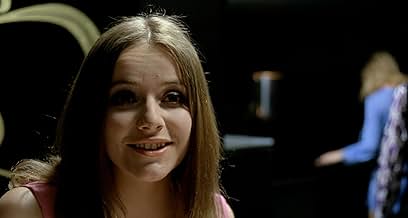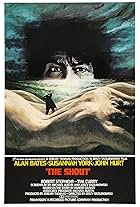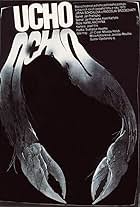IMDb RATING
7.2/10
7.8K
YOUR RATING
15-year-old dropout Mike takes a job at Newford Baths, where inappropriate sexual behaviour abounds, and becomes obsessed with his coworker Susan.15-year-old dropout Mike takes a job at Newford Baths, where inappropriate sexual behaviour abounds, and becomes obsessed with his coworker Susan.15-year-old dropout Mike takes a job at Newford Baths, where inappropriate sexual behaviour abounds, and becomes obsessed with his coworker Susan.
- Nominated for 1 BAFTA Award
- 1 nomination total
John Moulder-Brown
- Michael 'Mike'
- (as John Moulder Brown)
Anne-Marie Kuster
- Nightclub Receptionist
- (as Annemarie Kuster)
Christine Paul
- White Coat Girl
- (as Christina Paul)
Burt Kwouk
- Hot Dog Salesman
- (as Bert Kwouk)
Sean Barry-Weske
- Ruffian
- (uncredited)
- Director
- Writers
- All cast & crew
- Production, box office & more at IMDbPro
Storyline
Did you know
- TriviaDavid Lynch once claimed, "There's never been a color movie I've freaked out over except one, this thing called Deep End."
- Quotes
Michael 'Mike': I love her.
Cinema Owner: You perverted little monster.
Featured review
I first saw "Deep End" shortly after its release, it played at the base theater during my Air Force days. Films on base ran for only one day (three shows) and this was one of a handful that drew capacity crowds to the later shows due to "word of mouth" praise by those who attended the first screening. I finally got the opportunity to view it again last week and was not disappointed.
About all I recalled from my long ago first viewing was the Jane Asher full-size cardboard stand-up and the color red. Meaning that director Jerzy Skolimowski managed to create some powerful imagery that stayed in my mind over all those years, which is more than I can say for a lot of films. My association of the color red now makes perfect sense as that was obviously the imagery that Skolimowski meant to drill into each viewer's mind. From Asher's red hair (in the film itself and in the promotional poster where it trails off into blood), to the new color being painted on the walls of the bathhouse, to the blood that punctuates certain climatic moments in the story.
Skolimowski was Polanski's screenwriter for "Knife In the Water" and stylistically "Deep End" has a Polanski flavor (it certainly has its "Repulsion" moments). I was also reminded of a Judy Geeson film from about the same time "Goodbye Gemini" (1970); a London setting and a doomed pair of mismatched lovers. If you are looking for a more useful comparison think of a bizarre marriage of "The Summer of 42" (1971) and "Play Misty For Me" (1971).
But "Deep End" is too grounded to be overwrought; its romantic obsession - coming of age story rings surprisingly true. Probably because the gritty is evenly blended with the abstract in a storyline that nicely cuts between accidental and destined.
Just out of school, 15 year-old Mike (John Moulder-Brown) goes to work as the towel boy at a seedy London bath house. Asher plays Sue, an older co-worker who reveals that some of the clientèle are good for extra money in exchange for titillation in the private rooms. In an extraordinary scene an aging Diana Dors explores Mike's interest in football (soccer).
Sue is a mega-tease; she is stringing along a rich fiancée, having regular private sessions with one of Mike's former teachers, servicing assorted clients at the baths, and getting her perverse kicks turning on Mike. Sue is not atypical in her level of irresponsibility and Mike is not atypical in his level of naiveté. Stuff like this plays out everyday. But Mike's obsession begins to get a bit twisted when he first realizes that Sue and his former teacher have a relationship. And Skolimowski goes from broken mirror to ripped poster to broken glass to blood; substituting visual images for overwrought melodrama. Glass (mirror, fire alarm, diamond, light bulb) substitutes for Mike's fragile psyche and distorted perception, pictures (the PSA poster on the bulletin board and the cut-out girl Mike steals) substitute for a normal boy-girl relationship, and paint and hair substitute for blood.
"Deep End" is a film in motion, it never slows down and its scene transitions run from excellent to lame. I don't remember the theatrical showing well enough to say whether the version I just watched was intact. But I suspect that it has been hacked up and trimmed, which would explain the more inexplicable scene transitions. There is some support for this notion in that it has been converted into a 4-3 aspect ratio and has lost all the end credits except a few bars of the same Cat Stevens song that ran over the opening titles. If it ever gets a DVD release I hope they can find a better example to digitize.
The best way to understand it is to be open to the interplay of Skolimowski's images, these provide the texture of his film. The story may appear to be being told from Mike's point of view but it is the texture that allows the viewer to go beneath the surface of the deep end and to see the dance between love and death. Then again, what do I know? I'm only a child.
About all I recalled from my long ago first viewing was the Jane Asher full-size cardboard stand-up and the color red. Meaning that director Jerzy Skolimowski managed to create some powerful imagery that stayed in my mind over all those years, which is more than I can say for a lot of films. My association of the color red now makes perfect sense as that was obviously the imagery that Skolimowski meant to drill into each viewer's mind. From Asher's red hair (in the film itself and in the promotional poster where it trails off into blood), to the new color being painted on the walls of the bathhouse, to the blood that punctuates certain climatic moments in the story.
Skolimowski was Polanski's screenwriter for "Knife In the Water" and stylistically "Deep End" has a Polanski flavor (it certainly has its "Repulsion" moments). I was also reminded of a Judy Geeson film from about the same time "Goodbye Gemini" (1970); a London setting and a doomed pair of mismatched lovers. If you are looking for a more useful comparison think of a bizarre marriage of "The Summer of 42" (1971) and "Play Misty For Me" (1971).
But "Deep End" is too grounded to be overwrought; its romantic obsession - coming of age story rings surprisingly true. Probably because the gritty is evenly blended with the abstract in a storyline that nicely cuts between accidental and destined.
Just out of school, 15 year-old Mike (John Moulder-Brown) goes to work as the towel boy at a seedy London bath house. Asher plays Sue, an older co-worker who reveals that some of the clientèle are good for extra money in exchange for titillation in the private rooms. In an extraordinary scene an aging Diana Dors explores Mike's interest in football (soccer).
Sue is a mega-tease; she is stringing along a rich fiancée, having regular private sessions with one of Mike's former teachers, servicing assorted clients at the baths, and getting her perverse kicks turning on Mike. Sue is not atypical in her level of irresponsibility and Mike is not atypical in his level of naiveté. Stuff like this plays out everyday. But Mike's obsession begins to get a bit twisted when he first realizes that Sue and his former teacher have a relationship. And Skolimowski goes from broken mirror to ripped poster to broken glass to blood; substituting visual images for overwrought melodrama. Glass (mirror, fire alarm, diamond, light bulb) substitutes for Mike's fragile psyche and distorted perception, pictures (the PSA poster on the bulletin board and the cut-out girl Mike steals) substitute for a normal boy-girl relationship, and paint and hair substitute for blood.
"Deep End" is a film in motion, it never slows down and its scene transitions run from excellent to lame. I don't remember the theatrical showing well enough to say whether the version I just watched was intact. But I suspect that it has been hacked up and trimmed, which would explain the more inexplicable scene transitions. There is some support for this notion in that it has been converted into a 4-3 aspect ratio and has lost all the end credits except a few bars of the same Cat Stevens song that ran over the opening titles. If it ever gets a DVD release I hope they can find a better example to digitize.
The best way to understand it is to be open to the interplay of Skolimowski's images, these provide the texture of his film. The story may appear to be being told from Mike's point of view but it is the texture that allows the viewer to go beneath the surface of the deep end and to see the dance between love and death. Then again, what do I know? I'm only a child.
- aimless-46
- Jan 17, 2010
- Permalink
- How long is Deep End?Powered by Alexa
Details
Box office
- Gross worldwide
- $454
Contribute to this page
Suggest an edit or add missing content


































